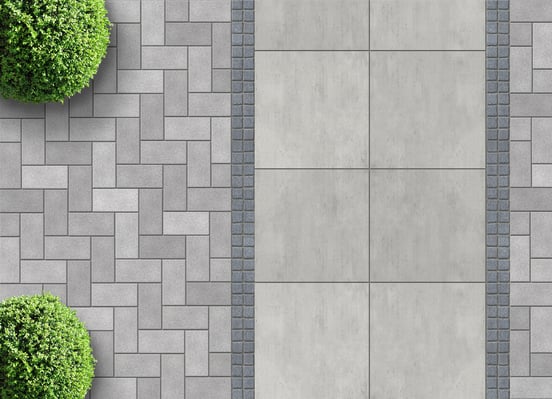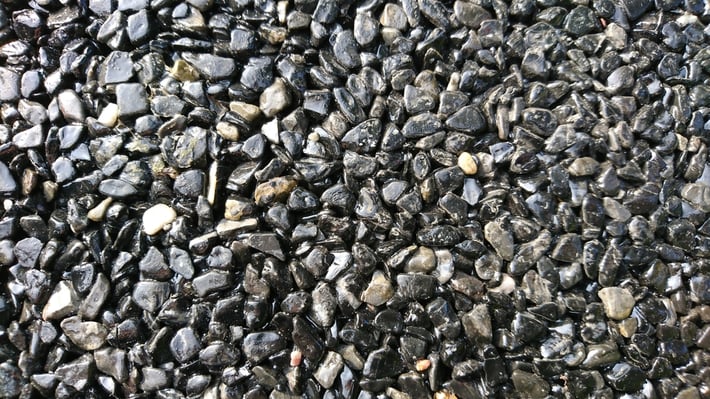Pervious concrete is a special type of high porosity concrete, made from a mixture of cement, water, coarse aggregate and a minimum amount of fine aggregate (sand). Pervious concrete creates a porous medium, which allows water from precipitation and other sources to pass through and reach the underlying soil. This reduces runoff from a site while recharging groundwater levels. Permeable concrete has applications in sustainable construction and is often used in sidewalks, parking areas and greenhouses.
The use of permeable concrete is recognized as a Stormwater Best Management Practice by the U.S. Environmental Protection Agency (EPA) as it provides pollution control. Drainage systems used to control stormwater runoff are becoming more difficult to construct due to their size and the cost of complying with stormwater regulations. Using permeable concrete for paved areas reduces runoff, which also reduces the need for stormwater retention ponds and the required storm sewer capacity.
Make your construction projects more sustainable and environmentally friendly.
Permeable concrete filters rainwater naturally, reducing the amount of pollutants that reach streams and other bodies of water. This concrete works as a rainwater retention basin and helps maintain groundwater levels in the area. Another benefit of permeable concrete is reducing the impact of construction on nearby trees, as it allows the transfer of water and air to the root system.
How is permeable concrete installed?

Pervious concrete is typically delivered to project sites with ready-mix trucks. A vibrating table is needed to level it and the concrete is then compacted with a heavy steel roller to increase strength. The curing process is complex due to the low water content: after placement, the permeable concrete is sprayed with water, covered with a plastic sheet and kept moist for at least 7 days to allow adequate hydration. In this way, permeable concrete can achieve the expected strength.
How much rainwater can permeable concrete capture?
Permeable concrete used for paving can absorb 3 to 5 gallons of rainwater per minute per square foot. This generally exceeds the flow rate needed to prevent runoff in most rain events. Pervious concrete may use an underlying layer of coarse gravel to trap water beneath the pavement, or the water may reach the ground directly.
The retention area created by permeable concrete prevents a significant portion of the polluted runoff that occurs with impervious pavement. There is also a filtration process, as the water is purified as it percolates through the open cells of the pavement. Aerobic bacteria help break down pollutants and harmful chemicals.
Main environmental benefits of permeable concrete
Stormwater runoff is one of the main sources of water pollution: about 90% of surface pollutants are transported to bodies of water by the first 1.5 centimeters of rain. There are three main pollutants in urban runoff: sediment, heavy metals and hydrocarbons.

The oil that runs from vehicles onto the pavement is a source of hydrocarbons in urban runoff. Another source responsible for 90-95% of hydrocarbons is the binder and sealant used in asphalt pavements. Municipal and EPA regulations are strict when dealing with stormwater management, and permeable concrete has become a viable solution with many benefits:
- Recharges groundwater levels.
- Less irrigation is needed for landscaping as the water enters the soil.
- Reduces the amount of untreated runoff entering storm sewers.
- Prevents oil pollution of asphalt pavement.
- Mitigates damage to aquatic ecosystems.
- It does not absorb and store heat like a typical floor, due to its light color and structure.
- It is safer to drive or walk as water is absorbed and puddles are reduced.
Limitations of Pervious Concrete and Special Considerations
Previous concrete is an excellent option for certain applications, but the physical properties of its surface limit its use in many cases. It has a rough honeycomb surface and shows a certain degree of fraying. This can be a problem on high-traffic pavements, as tires can loosen aggregates on the surface. One possible solution is to rough up the pavement, but most builders decide to use conventional pavement with adequate storm management systems.
As with any pavement system, permeable concrete requires adequate design to perform as expected. The substrate below the pavement is fundamental to the project, as it must be capable of storing water as it percolates underground. Soil studies and site-specific stormwater calculations are required for proper design and should be performed by a stormwater management engineer.

